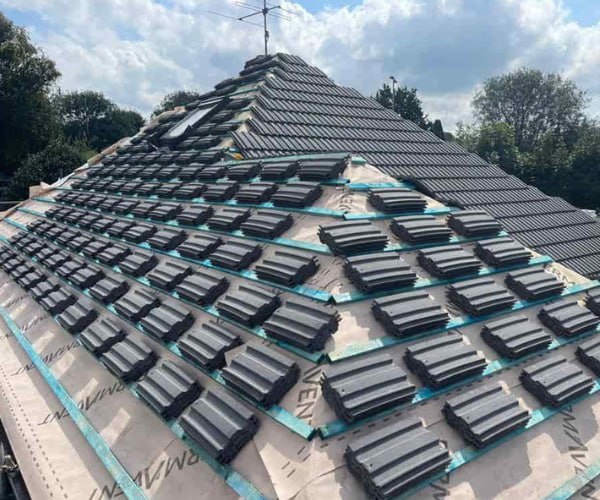How to Tell If You Need a Roof Replacement or Just Repairs
Introduction
The roof is one of the most important parts of any property, providing protection from the elements and ensuring structural stability. Over time, exposure to weather, ageing materials, and general wear and tear can cause issues that require attention. However, not all roofing problems necessitate a full replacement—many can be resolved with targeted repairs. Knowing when to repair or replace a roof can save homeowners time, money, and potential damage to their property.
At LKN Roofing Shortstown, we provide expert roofing services in Shortstown, Bedfordshire, helping homeowners assess the condition of their roofs and choose the best course of action. This article outlines the key signs to help determine whether a roof needs repairs or a full replacement.
Key Takeaways
- Minor damage, such as a few missing tiles, can often be repaired.
- Persistent leaks, widespread damage, or structural issues may require a full replacement.
- Roofs over 20–30 years old may be nearing the end of their lifespan.
- Professional inspections help identify hidden issues and provide expert recommendations.
- Investing in the right solution prevents costly future repairs and enhances property value.
Signs That Your Roof Needs Repairs
1. Isolated Leaks or Water Damage
If a roof has a small, localised leak—such as around a chimney, skylight, or flashing—it may be possible to fix the issue with targeted repairs. Signs of minor water damage include:
- A damp patch on the ceiling.
- Water stains around roof penetrations.
- A small amount of water entering the loft after heavy rain.
2. A Few Missing or Damaged Tiles
A single storm or strong wind can sometimes dislodge a few tiles or cause minor cracks. If most of the roof is still intact, replacing the affected tiles can restore protection without the need for a full roof replacement.
3. Blocked or Overflowing Gutters
Water spilling over the edges of the roof could indicate clogged gutters rather than a roofing failure. Clearing debris and ensuring proper drainage may resolve the issue without requiring major repairs.
4. Minor Flashing Issues
Flashing is used to seal joints around chimneys, vents, and skylights. If flashing has come loose or developed small gaps, it can often be repaired or resealed to prevent leaks.
5. Moss and Algae Growth
While moss and algae on a roof can indicate excess moisture, they do not always mean a replacement is necessary. In many cases, cleaning and applying a protective treatment can resolve the issue without replacing the entire roof.
Signs That Your Roof Needs a Full Replacement
1. The Roof Is Over 20–30 Years Old
Most roofs have a lifespan of 20 to 30 years, depending on the materials used. If a roof is approaching this age and showing signs of deterioration, replacing it may be the best long-term solution.
2. Widespread Leaks and Water Damage
If water is penetrating multiple areas of a roof, patching individual leaks may not be sufficient. Signs of extensive water damage include:
- Large water stains across ceilings or walls.
- Persistent damp or mould growth in the loft.
- Water dripping from multiple areas during rain.
3. Sagging or Structural Weakness
A sagging roof is a serious issue that suggests underlying structural problems. This could be due to long-term water damage, poor installation, or weakened roof supports. If the structure is compromised, a full replacement is usually necessary to prevent further damage or collapse.
4. Extensive Tile or Shingle Damage
If a large number of tiles are cracked, broken, or missing, it may be more cost-effective to replace the entire roof rather than continuously repairing sections. Signs of widespread roof failure include:
- Granules from shingles collecting in gutters.
- Large patches of missing or loose tiles.
- Uneven or curling shingles that no longer provide proper coverage.
5. Frequent and Costly Repairs
If a roof requires constant repairs, the cumulative costs may exceed the price of a full replacement. Investing in a new roof eliminates the need for ongoing patchwork fixes and provides a long-term solution.
The Importance of Professional Roof Inspections
While homeowners can spot some visible signs of damage, many roofing problems are not immediately obvious. A professional roofing inspection can:
- Identify hidden structural issues.
- Assess the overall condition of materials.
- Provide an expert recommendation on repairs vs. replacement.
- Prevent future costly damage by addressing problems early.
At LKN Roofing Shortstown, we offer comprehensive roof inspections in Shortstown, Bedfordshire, ensuring homeowners receive the best advice and solutions for their property.
Conclusion
Deciding between roof repairs and a full replacement depends on the extent of the damage, the age of the roof, and long-term cost considerations. Minor issues such as small leaks, missing tiles, or flashing problems can often be repaired. However, widespread damage, structural weaknesses, and an ageing roof may require a full replacement to ensure lasting protection.
For expert roofing assessments in Shortstown, Bedfordshire, LKN Roofing Shortstown provides professional repair and replacement services. Contact us today to schedule an inspection and find the best solution for your roof.
Call us on: 01234 860 695
Click here to find out more about LKN Roofing Shortstown
Click here to complete our contact form and see how we can help with your roofing needs.

